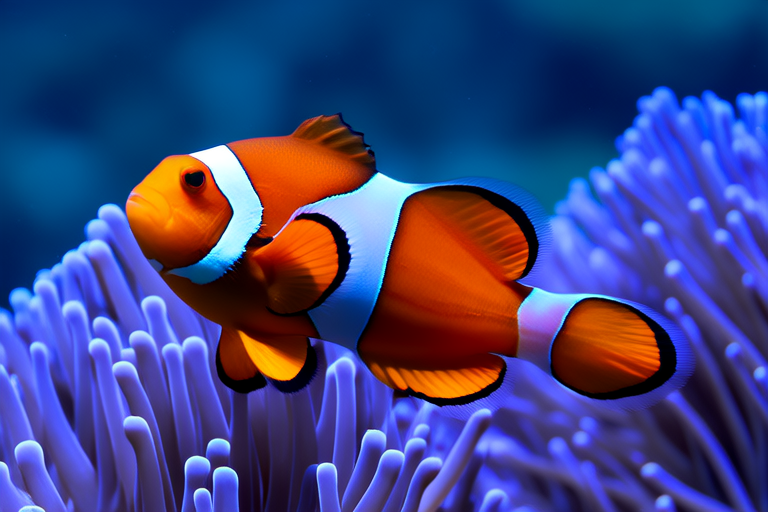Top 10 Fascinating Facts About Clownfish You Never Knew
Clownfish, those vibrant orange and white fish often seen darting around tropical reefs, are more than just a pretty face or a popular animated character. These small, saltwater fish have a fascinating array of behaviors, biological quirks, and ecological roles that make them one of the most intriguing creatures in the ocean. Here are ten unique and intriguing facts about clownfish you might not know.
Fact 1: They Have a Unique Relationship with Sea Anemones
The most well-known fact about clownfish is their symbiotic relationship with sea anemones. But did you know that this relationship is mutually beneficial? Clownfish live among the tentacles of sea anemones, which provide them protection from predators. In return, clownfish bring food to the anemone and help keep it clean by eating parasites and dead tissue. This partnership is so effective that clownfish can even swim among the stinging tentacles without getting hurt because they have a protective mucus layer that prevents the anemone’s toxins from affecting them.
Fact 2: Clownfish Are Born Genderless
Clownfish start out as genderless, but they develop into males or females based on the needs of their social group. If the dominant female dies, the largest male will change sex and become the new dominant female. This remarkable ability allows clownfish populations to adapt quickly to changes in their environment, ensuring the survival of the species.
Fact 3: They Communicate Through Body Language
Clownfish are highly social creatures, and they communicate with each other through a variety of body movements and colors. For example, when they want to establish dominance, they will swim with their fins spread wide and their colors intensified. When they’re scared or submissive, they’ll swim close to the anemone and hide behind its tentacles. Understanding these signals can help divers and aquarists better appreciate the complex social structure of clownfish communities.
Fact 4: Clownfish Can Be Quite Aggressive
Despite their cute appearance, clownfish can be surprisingly aggressive, especially when defending their territory. They will chase away other fish, including larger ones, that come too close to their anemone home. This territorial behavior helps protect their food source and keeps potential threats at bay, ensuring the safety of the entire group.
Fact 5: They Are Excellent Swimmers
Clownfish are incredibly agile swimmers, thanks to their streamlined bodies and strong tail fins. They can swim backward, forward, and even hover in place, which allows them to navigate the intricate coral reefs where they live. Their agility also helps them evade predators and catch food efficiently.
Fact 6: Clownfish Are Omnivores
Contrary to popular belief, clownfish don’t just eat algae. They are omnivores, meaning they eat both plant and animal matter. Their diet includes zooplankton, algae, and leftovers from the anemone’s meals. This diverse diet helps them get all the nutrients they need to thrive in their environment.
Fact 7: They Are Highly Sensitive to Water Quality
Clownfish are particularly sensitive to changes in water quality, making them excellent indicators of environmental health. If the water becomes polluted or the temperature rises too much, clownfish may show signs of stress, such as reduced activity or abnormal behavior. This sensitivity makes them important sentinels for monitoring the health of coral reef ecosystems.
Fact 8: Clownfish Are Native to Warm Waters
Clownfish are native to the warm waters of the Indian and Pacific Oceans, where they live among the vibrant coral reefs. They prefer shallow waters near the coast, where the temperature ranges from 75 to 85 degrees Fahrenheit. The tropical climate provides the ideal conditions for their survival, with plenty of food and shelter.
Fact 9: They Are Social Creatures
Clownfish live in groups, usually consisting of a breeding pair and several non-breeding males. Within the group, there is a clear hierarchy, with the dominant female at the top. This social structure helps ensure the survival of the group, as the dominant pair takes care of reproduction while the others assist in protecting and caring for the young.
Fact 10: Clownfish Have Been Studied for Medical Research
Believe it or not, clownfish have been studied for their potential medical applications. Researchers are investigating how the protective mucus layer on their skin could inspire new treatments for human diseases, including cancer and infections. By understanding how clownfish defend themselves against the anemone’s toxins, scientists hope to develop new medications that could benefit human health.
Conclusion: The Uniqueness and Importance of Clownfish
From their unique relationship with sea anemones to their ability to change sex, clownfish are truly fascinating creatures. Their vibrant colors, playful personalities, and vital role in maintaining healthy coral reef ecosystems make them a beloved subject of study and admiration. As we continue to explore the mysteries of the ocean, clownfish will undoubtedly remain a source of wonder and inspiration for generations to come. Understanding and protecting these amazing fish is crucial for preserving the delicate balance of our planet’s marine ecosystems.
